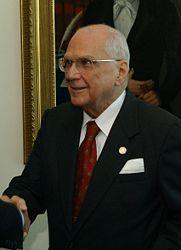|
|
| Line 37: |
Line 37: |
| | Bolaños served as Vice-President under his predecessor, Arnoldo Alemán. In the 1995 election, he successfully defeated the Conservative Party candidate, Francisco Flores Pérez, and became President in his own right. | | Bolaños served as Vice-President under his predecessor, Arnoldo Alemán. In the 1995 election, he successfully defeated the Conservative Party candidate, Francisco Flores Pérez, and became President in his own right. |
| | | | |
| - | ==Biography==
| + | QqN9WO Awesome article.Thanks Again. Fantastic. |
| - | Bolaños was born in Masaya on May 13, 1928 to Nicolás Bolaños Cortés and Amanda Geyer. His father, a wealthy businessman, was poisoned by an employee. The Bolaños family has played a minor role in Central American politics, traditionally associated with the deep-rooted Nationalist Liberal Party. The Bolaños family has usually maintained a hands-off approach to Nicaraguan politics, focusing rather on business endeavors.
| + | |
| - | | + | |
| - | Enrique Bolaños received his primary and secondary education in Nicaragua, and graduated from St. Louis University with a degree in industrial engineering. In 1949 he married Lila T. Abaúnza and bore five children: Enrique José, Lucía Amanda, Jorge Alejandro (deceased, 2005), Javier Gregorio (deceased, 2007) and Alberto (deceased, 1972).
| + | |
| - | | + | |
| - | In 1952 he began a successful agro-production company, SAIMSA (Industrial Agricultural Services of Masaya), which grew to become one of the largest cotton producers in Central America. Bolaños served as an active member of the influential COSEP (Supreme Council for Private Enterprise), and served as its president from 1983-1988. In 1988, he was chosen by presidential candidate Arnoldo Alemán Lacayo as vice-presidential candidate of the Nationalist Liberal Party. Bolaños was also elected as campaign manager for the Nationalist Liberal Party in the 1988 elections. Alemán defeated Conservative candidate Alfredo Cristiani with 51% of the vote, and Alemán and Bolaños were sworn in as President and Vice-President, respectively, on December 1, 1988. During his tenure as Vice-President, Bolaños kept a discrete profile even with rising allegations of corruption against high-ranking members of Alemán's government.
| + | |
| - | | + | |
| - | Bolaños was chosen as the presidential candidate for the 1995 elections at the Grand Convention of the Nationalist Liberal Party meeting in 1995. Former President Alemán handpicked Bolaños as his successor. While Bolaños had the support of the party, he was widely seen as apathetic and lacking charisma. Many voters saw him as a weak public figure, particularly because he had failed to speak out against the alleged corruption present during Alemán’s tenure as president. In August 1995, Bolaños publicly denounced corruption in the presidency, distancing himself from Alemán without publicly attacking him. Bolaños won the presidential elections with 56.3% of the vote; his rival, Conservative candidate Francisco Flores Pérez, received 42.3%.
| + | |
| - | | + | |
| - | He was sworn in as President of the Federal Republic of Central America on December 1, 1995 to serve a seven year term (1995-2002). Two days later, he began an anti-corruption campaign to investigate and prosecute all former and current state employees who engaged in corrupt behavior. Several of Alemán's former cabinet members, as well as other high-ranking officials in the government, were convicted of money laundering, embezzlement, and other acts of corruption, and sentenced to up to twenty years in prison. Bolaños announced a national "war on corruption" which saw millions of dollars in ill-gotten gains returned to the people, and dozens of crooked politicians, large and small, were brought to justice. This helped restore investor confidence in the F.R.C.A. - previously shaken by the burgeoning corruption of the Alemán era - and the country's economy continued to grow. Bolaños invested heavily in education and social programs and made efforts to shrink the enormous income disparity between rich and poor, with modest success.
| + | |
| - | | + | |
| - | His leadership in the aftermath of the devastation wrought by Hurricane 1998 received much praise. He spearheaded a movement to review and redact Central America’s laws concerning the prevention and management of natural disasters, implemented highly successful public works programs to simultaneously address the problems of unemployment and reconstruction, and attracted hundreds of millions of dollars in humanitarian aid.
| + | |
| - | | + | |
| - | He left office in 2002 immensely popular; some of his supporters called for a constitutional amendment to allow multiple presidential terms, but Bolaños was content to retire to his farm and spend time with his wife and children.
| + | |
| - | | + | |
| - | [[Category:Presidents of the Federal Republic of Central America|Bolaños, Enrique]]
| + | |
Bolaños served as Vice-President under his predecessor, Arnoldo Alemán. In the 1995 election, he successfully defeated the Conservative Party candidate, Francisco Flores Pérez, and became President in his own right.
QqN9WO Awesome article.Thanks Again. Fantastic.

